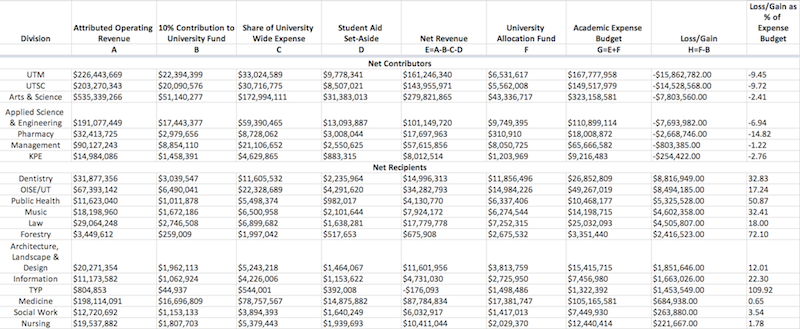Where does the money go?
If you haven’t read it yet, there’s a great article in the Varsity this week about how the university allocates funding. You should read the article before continuing, or else my comments on some of the lines in the funding chart below will be a little confusing.
The thing to keep in mind when reading this is that the University Fund (UF) is designed to allow the central admin to achieve a wide range of priorities, and some of the UF “winners” actually have pretty good reasons to get extra money.
You’ll notice that Dentistry makes off pretty well. However, most of their UF allocation apparently goes towards funding the free dental clinic that they run, as this clinic makes no revenue. It’s an important learning opportunity for students–they get to hone their skills on real people, but it’s also important for the community, as it provides a needed service to the nearby community. Clients of the free dental community tend to be from a low socio-economic background, so there’s a social good to allocating extra funding to the program.
The extra money that Music gets is a gesture of fairness towards students. A year or two ago, due to financial problems, the faculty introduced an additional ancillary fee to help keep the program in good financial health. A large amount of the UF allocation is for matching funds for this fee, which is problematic, but unfortunately necessary.
Lastly, TYP is one of UofT’s foremost access programs, started by the black community in Toronto, and designed to help students who are racialized, aboriginal, from the LGBT community, or other equity-seeking groups access university. The program is the only way for marginalized students to come to UofT without the regular high school credentials. It’s strength lies in being a community for students–having living and common space, strong connections to alumni, and faculty that can relate to students. Because of the intensive needs of the program, it has much higher operating costs and financial aid needs than other programs, and so needs a high UF allocation. Unfortunately, at an institution driven by prestige and budget pressures, it doesn’t get treated as well as it should, and its budget is set to decline in nominal terms over the next five years. TYP deserves more than a paragraph, but for the sake of understanding why it has such a high UF allocation, it’s important to know that it has high needs, and performs a vital social justice and access role at UofT.
As for the other divisions, I have no idea.
If you have any questions or comments, feel free to email me at [email protected]
